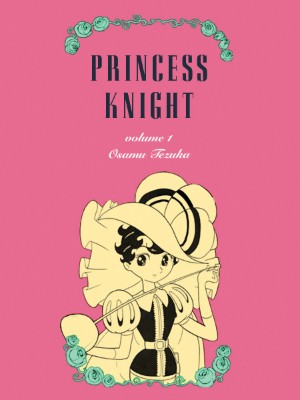By Osamu Tezuka. Released in Japan as “Ribon no Kishi” by Kodansha, serialized in the magazine Nakayoshi. Released in North America by Vertical.
We’ve been waiting for this one a while. Gripping, depressing Tezuka seinen is all very well and good, but sometimes you have to bring out the big guns. And there are few guns bigger than Princess Knight, which most argue is one of the most influential titles ever, inspiring a generation of shoujo artists. There are actually several versions of the title; the original, in 1954; a sequel with the heroine’s children, in 1958; a rewrite and expansion in 1963; and a science-fiction tie-in to an anime in 1967. Vertical is releasing the 3rd and most well-known version.
Though enjoyable to children and adults alike, this work is definitely aimed at the younger reader, with its premise being couched in fairy tale language. In heaven, they give out girl hearts and boy hearts to babies about to be born, determining their gender. A mischievous angel, Tink, feeds a baby a boy heart right before God gives the same baby a girl heart. As a result, the girl is both with hearts for both genders. And what’s worse, the girl is a princess of the kingdom of Silverland! Now the girl is raised as a boy, to avoid rousing the suspicious of the evil Duke Duralumin, who wants his own son on the throne.
The inherent sexism of the kingdom (which must have a male ruler) is offset by Sapphire herself, who manages to be incredibly badass. Yes, there are those moments where the series undercuts itself – at one point, Sapphire’s boy heart is temporarily removed and she grows weak and loses her fencing skills – but for the most part she is a bright and active heroine, one who longs to be a young woman but who also does not want to give up the freedoms of being a young man. Things aren’t subtle here – her love for Prince Charming (yes, really) verges on the histrionic at times – but Sapphire remains a great heroine throughout, who you want to see emerge victorious.
That may be difficult, though. As with many stories in this vein, there are any number of traumas and disasters that befall her. Her father is killed, her mother imprisoned. She is forced to work menial tasks a la Cinderella, turned into a swan, and kidnapped by pirates. Sexy pirates. Once it gets started, the action never really lets up, just like the best children’s stories. Not that it’s all grim tidings. The basic plot trimmings may sound like Disney, but a lot of the gags are also right out of animated cartoons, with circus horses mocking the King, plucky mice helping the heroine escape, and the villain double-act of Duralumin and Nylon hamming it up for all they’re worth.
Vertical is releasing the three original Japanese volumes here as two slightly larger ones, and so naturally we end with a cliffhanger. Their presentation is excellent, with a lovely original cover (whose color is slightly more purple than the picture above, the only one I can find online), and the translation captures the broad, declamatory language. As Sapphire swashbuckles her way through various deathtraps and tries to gain her love and her femininity while remaining strong and speaking her mind, you’ll find that you absolutely can’t put the book down. The second volume cannot come soon enough.


I thought I remembered Ed Chavez saying somewhere that Vertical had licensed the 1954 original. So, I’m actually very happy that it seems to be the 1963 version!
Ah, here is the link from ANN. The line about Princess Knight is at the bottom of the article.
“Update: Chavez indicates that Vertical will release the original Shoujo Club version of the Princess Knight manga.”
He was incorrect (no doubt why they clarified again at the panel). I’ve seen a copy of the Japanese Shoujo Club edition. This isn’t it, it’s the Nakayoshi.
Hooray! :)
Pingback: Sailor Moon soars, Kurosagi reappears « MangaBlog
Good to hear it’s the 60s version — it’s probably the less important historically, but having flipped through both, I like the big, flamboyant art in that version much better than the small tight panels of the 50s one.